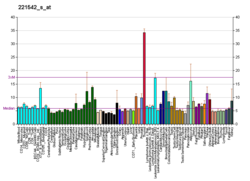| ERLIN2 |
|---|
|
| Identifiers |
|---|
| Aliases | ERLIN2, C8orf2, Erlin-2, NET32, SPFH2, SPG18, ER lipid raft associated 2 |
|---|
| External IDs | OMIM: 611605; MGI: 2387215; HomoloGene: 5193; GeneCards: ERLIN2; OMA:ERLIN2 - orthologs |
|---|
| Gene location (Human) |
|---|
 | | Chr. | Chromosome 8 (human)[1] |
|---|
| | Band | 8p11.23 | Start | 37,736,601 bp[1] |
|---|
| End | 37,758,422 bp[1] |
|---|
|
| Gene location (Mouse) |
|---|
 | | Chr. | Chromosome 8 (mouse)[2] |
|---|
| | Band | 8|8 A2 | Start | 27,513,289 bp[2] |
|---|
| End | 27,530,356 bp[2] |
|---|
|
| RNA expression pattern |
|---|
| Bgee | | Human | Mouse (ortholog) |
|---|
| Top expressed in | - Epithelium of choroid plexus
- renal medulla
- Achilles tendon
- islet of Langerhans
- parotid gland
- germinal epithelium
- mucosa of paranasal sinus
- bronchial epithelial cell
- kidney tubule
- caput epididymis
|
| | Top expressed in | - spermatocyte
- otolith organ
- utricle
- Epithelium of choroid plexus
- right kidney
- vestibular membrane of cochlear duct
- decidua
- superior cervical ganglion
- gastrula
- proximal tubule
|
| | More reference expression data |
|
|---|
| BioGPS | 
 | | More reference expression data |
|
|---|
|
| Gene ontology |
|---|
| Molecular function | - cholesterol binding
- protein binding
- protein tyrosine kinase activity
- ubiquitin protein ligase binding
| | Cellular component | - integral component of membrane
- membrane raft
- membrane
- endoplasmic reticulum
- plasma membrane
- endoplasmic reticulum membrane
- cytosol
- protein-containing complex
| | Biological process | - SREBP signaling pathway
- steroid metabolic process
- cholesterol metabolic process
- negative regulation of cholesterol biosynthetic process
- negative regulation of fatty acid biosynthetic process
- lipid metabolism
- ubiquitin-dependent ERAD pathway
- peptidyl-tyrosine phosphorylation
- transmembrane transport
| | Sources:Amigo / QuickGO |
|
| Orthologs |
|---|
| Species | Human | Mouse |
|---|
| Entrez | | |
|---|
| Ensembl | | |
|---|
| UniProt | | |
|---|
| RefSeq (mRNA) | |
|---|
NM_001003790
NM_001003791
NM_007175
NM_001362878
NM_001362880 |
| NM_153592
NM_001364476
NM_001364477
NM_001379175
NM_001379176
|
|---|
NM_001379177
NM_001379178 |
|
|---|
| RefSeq (protein) | |
|---|
NP_001003790
NP_001003791
NP_009106
NP_001349807
NP_001349809 |
| NP_705820
NP_001351405
NP_001351406
NP_001366104
NP_001366105
|
|---|
NP_001366106
NP_001366107
NP_001391043
NP_001391044
NP_001391045 |
|
|---|
| Location (UCSC) | Chr 8: 37.74 – 37.76 Mb | Chr 8: 27.51 – 27.53 Mb |
|---|
| PubMed search | [3] | [4] |
|---|
|
| Wikidata |
| View/Edit Human | View/Edit Mouse |
|



















